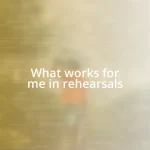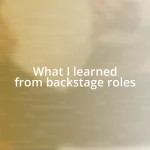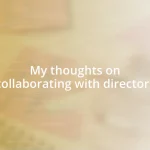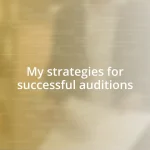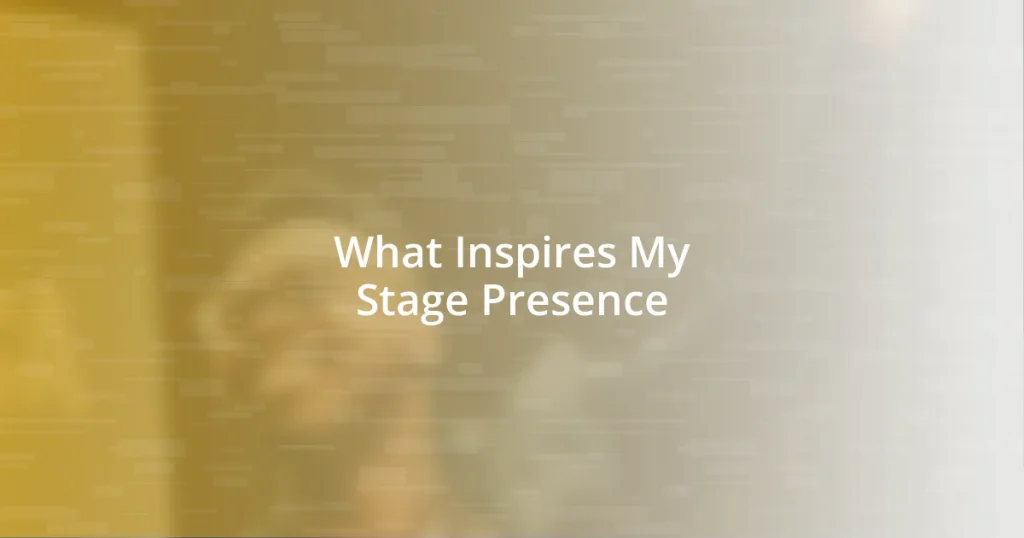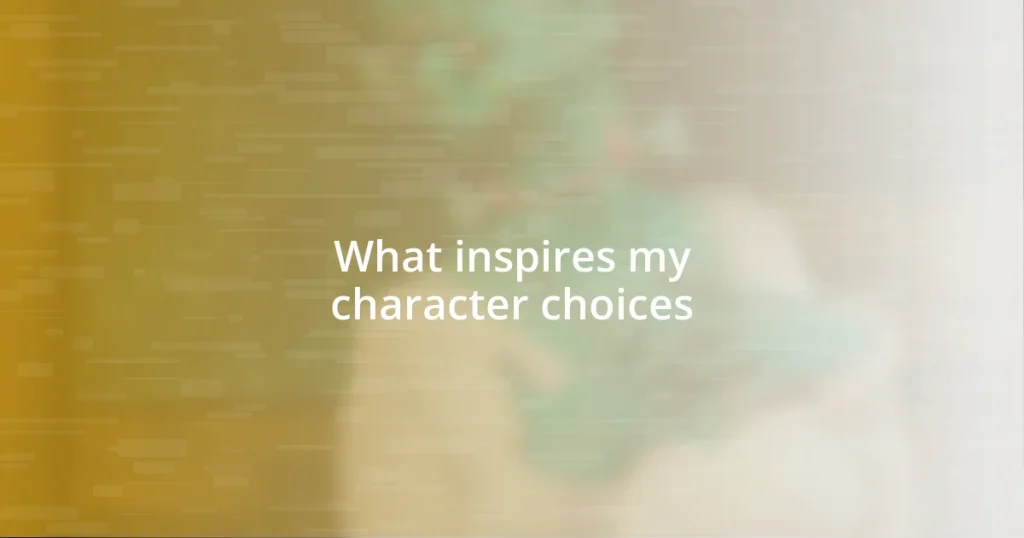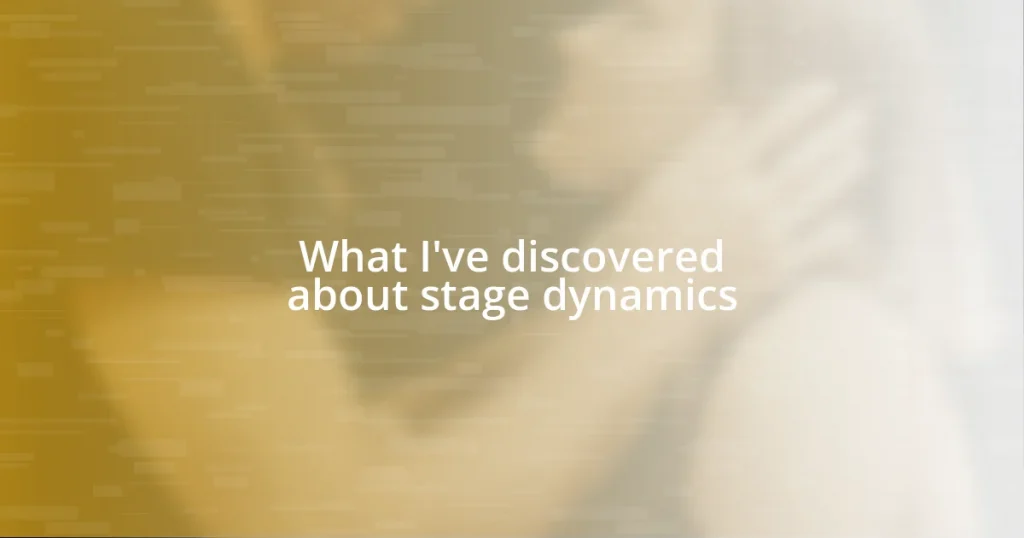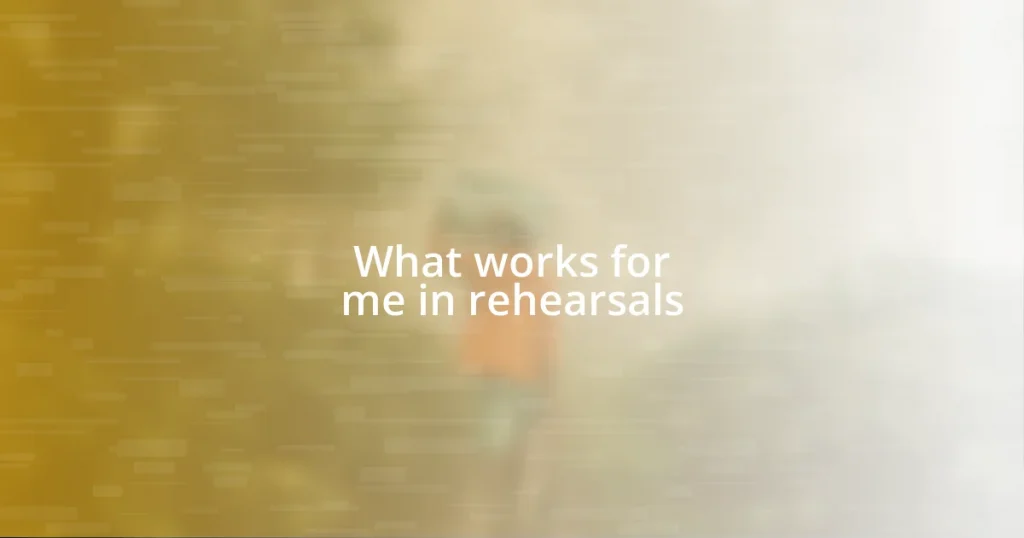Key takeaways:
- Stage presence enhances audience connection and emotional engagement, transforming performances into memorable experiences.
- Effective techniques to improve stage presence include body language, voice modulation, and thorough practice to build confidence.
- Overcoming stage fright can be achieved through deep breathing, familiarization with the stage, and visualizing success before performance.

Understanding stage presence importance
Stage presence is crucial because it transforms a performance from mere execution into a captivating experience. I remember the first time I stepped on stage; the energy from the audience was electric, and I realized that my connection with them made all the difference. Have you ever felt that thrill when a performer commands the room? That’s the magic of stage presence at work.
Moreover, effective stage presence can create an emotional bond with the audience. In one of my performances, I noticed a woman in the crowd visibly moved by the lyrics; it was incredible to see how my energy translated into her emotions. Isn’t it fascinating how a performer’s confidence can evoke such strong feelings in others?
Additionally, stage presence fosters credibility and authority. When I speak, I strive to embody the message I’m delivering, as this assurance resonates with the audience. What impact do you think a confident performer has on those watching? If we can project passion, we not only engage our audience but also inspire them to connect with the content on a deeper level.

Techniques to enhance stage presence
To enhance stage presence, one effective technique is utilizing body language. I’ve found that open gestures and purposeful movements can dramatically impact how the audience perceives a performer. During one of my shows, I made a conscious effort to eliminate nervous habits, like fidgeting with my hair. Instead, I grounded myself, opened my arms, and made eye contact, which not only eased my nerves but also drew the audience in. Have you ever noticed how some performers seem to fill the entire space just with their physicality?
Voice modulation is another powerful tool. Varying pace, volume, and tone can keep the audience engaged and highlight emotional peaks. I recall a time when I emphasized key phrases by lowering my voice, making the crowd lean in closer. The electric atmosphere that followed was unforgettable. It’s fascinating how a slight change in how we speak can foster an intimate connection, don’t you think?
Lastly, practice and preparation cannot be overlooked. I’ve experienced the shift in my confidence levels when I know my material inside and out. Rehearsing not only solidifies the content but also allows for spontaneity during a performance. Embracing the familiar gives room for creativity and excitement. It’s the blend of knowing your stuff and feeling free on stage that truly captivates those watching.
| Technique | Description |
|---|---|
| Body Language | Using open gestures and purposeful movements to engage the audience. |
| Voice Modulation | Varying pace, volume, and tone to capture attention and convey emotion. |
| Practice & Preparation | Knowing your material thoroughly to boost confidence and spontaneity. |

The role of body language
Body language plays an integral role in a performer’s stage presence. I once had an experience where, during a particularly intense moment in my speech, I raised my arms wide and opened my stance. That single gesture not only drew the audience’s eyes toward me but also created a palpable sense of openness and invitation. It was almost as if I could physically feel the audience lean in, eager to connect and share that moment with me.
Here are some key aspects of body language to consider:
- Posture: Standing tall and grounded exudes confidence and draws attention.
- Gestures: Using purposeful hand movements can emphasize points and keep engagement high.
- Facial Expressions: Smiling or showing appropriate emotions can create a deeper connection with the audience.
- Eye Contact: Making eye contact fosters intimacy and ensures that listeners feel acknowledged and involved.
By being mindful of these elements, I’ve noticed how my interactions with the audience become far more impactful. Each movement and expression serves not just as a tool for communication but as a bridge connecting me with those who chose to share the experience.

Engaging with the audience
Engaging with the audience is all about creating a shared experience. I remember a time when I paused mid-speech to acknowledge a particular person in the front row, giving them a nod and a smile. That brief moment felt electric, as if I had invited them into my world. It’s amazing how a simple gesture can transform the static relationship between speaker and audience into a dynamic dialogue.
Another technique I often rely on is storytelling. During one performance, I shared a personal story about overcoming a challenge, and the room fell silent. I could see heads nodding and eyes glistening with understanding. It made me wonder, how often do we connect on a deeper level simply through shared experiences? When I share my vulnerability, the audience responds with a warmth that makes the entire engagement feel truly personal.
Finally, asking questions is a great way to keep the audience engaged. I love to pose a rhetorical question, pause, and watch them react. Their expressions tell me they’re thinking, processing, and connecting. For instance, I once opened with, “How many of you have faced a moment of uncertainty?” The hands slowly rose, and suddenly, we were all in it together. It’s in these moments that I truly feel the audience and I become intertwined, all contributing to a memorable experience.

Overcoming stage fright strategies
When it comes to tackling stage fright, I’ve found that deep breathing can be a game changer. Just before I step on stage, I take a moment to inhale deeply and visualize the air filling me with confidence. This simple practice calms my nerves and centers my focus, allowing me to start my presentation with clarity. Have you ever noticed how much our breath can influence our state of mind?
Another strategy I’ve embraced is familiarization. Whenever I have a looming presentation, I make it a point to visit the stage beforehand. Standing in that space, imagining the audience’s faces, and rehearsing my material helps diminish the fear of the unknown. Once, I arrived at a venue early and spent time just walking the stage, articulating my lines softly. By the time I officially took the stage, it felt like stepping into a space I already knew, which made a remarkable difference.
Visualizing success has also been crucial for me. Before a big event, I spend a few quiet moments picturing myself delivering my message effortlessly. I imagine the audience’s enthusiastic reactions and feel that energy coursing through me. This mental rehearsal not only enhances my confidence but gives me a sense of purpose. After all, what’s more motivating than envisioning the joy of sharing something valuable with others?
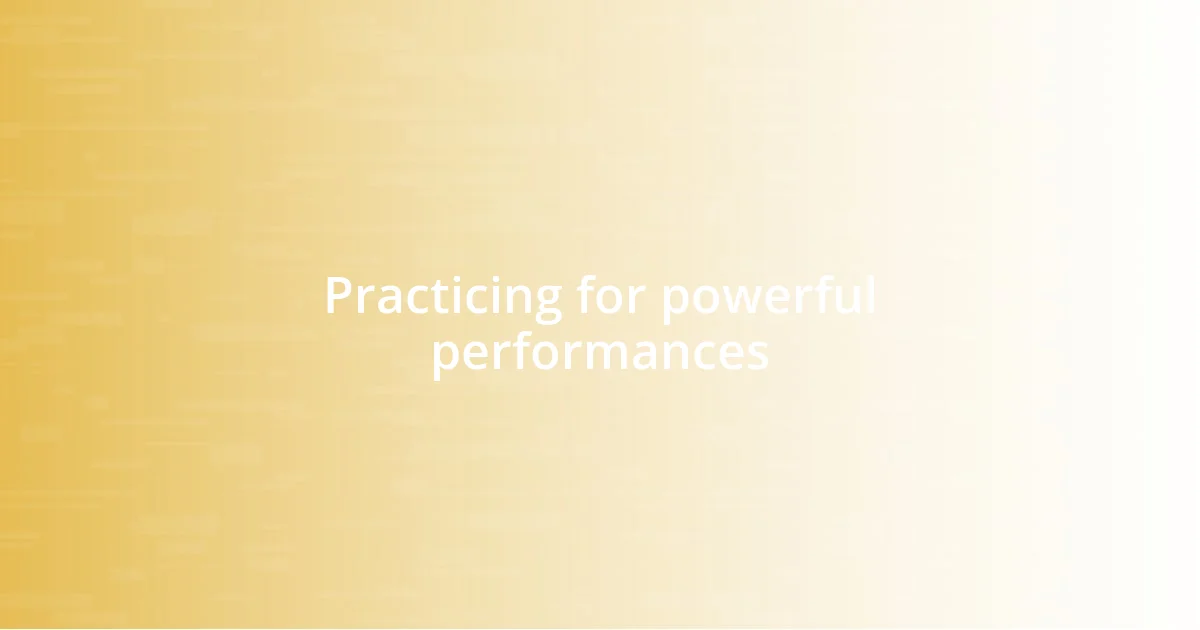
Practicing for powerful performances
Practicing for powerful performances is an art that requires both dedication and creativity. Personally, I find that creating a rehearsal routine that incorporates varied techniques makes a significant impact. For instance, during one preparation session, I combined voice modulation exercises with physical warm-ups. As I moved around the room, I noticed how my energy shifted, making me feel more vibrant and alive. Isn’t it interesting how our physical state can influence our vocal delivery?
One of my go-to strategies is recording my practice sessions. Listening back provides me with valuable feedback that I wouldn’t catch otherwise. I recall feeling surprised at how certain phrases sounded flat, lacking the passion I intended. Now, I focus on infusing those moments with emotion. Have you ever recorded yourself and felt a mix of cringe and insight afterward? It’s humbling, but it’s a fantastic way to ensure each word resonates during the real performance.
Additionally, I absolutely swear by practicing in front of friends—or even family pets! Their reactions can be telling. A friend once chuckled at a joke I thought was hilarious, and I realized I needed to tweak my timing. It’s moments like these that not only refine my delivery but also deepen my connection to the material. Do you ever practice in an environment that pushes you out of your comfort zone? Those experiences often yield the most authentic performances.


